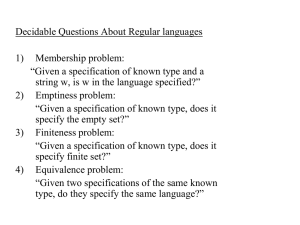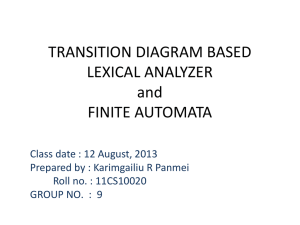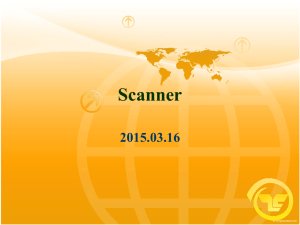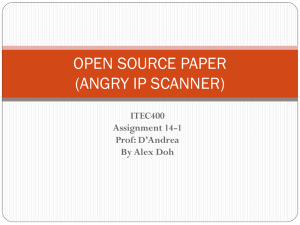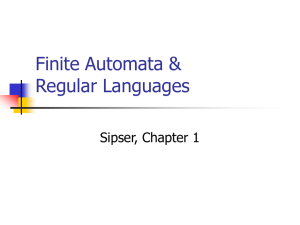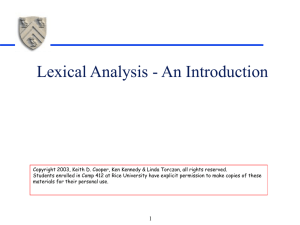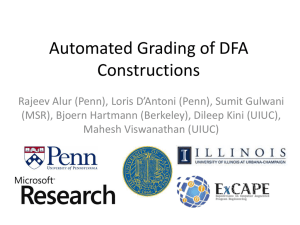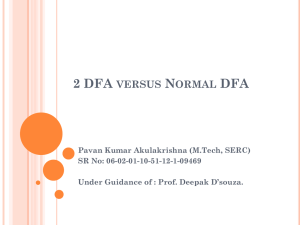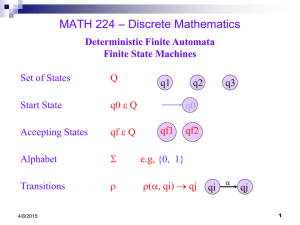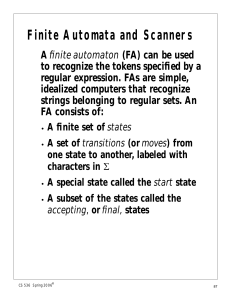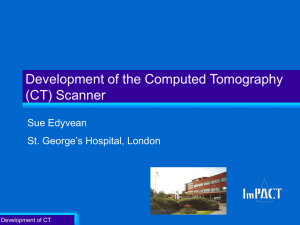Slides
advertisement
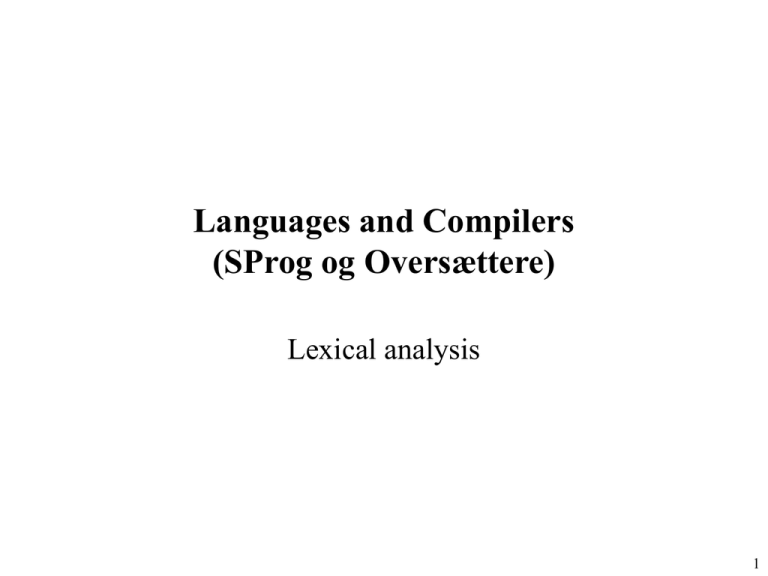
Languages and Compilers
(SProg og Oversættere)
Lexical analysis
1
Lexical analysis
– Describe the role of the lexical analysis phase
– Describe regular expressions and finite automata
2
Syntax Analysis: Scanner
Dataflow chart
Source Program
Stream of Characters
Scanner
Error Reports
Stream of “Tokens”
Parser
Error Reports
Abstract Syntax Tree
3
1) Scan: Divide Input into Tokens
An example mini Triangle source program:
let var y: Integer
in !new year
y := y+1
Tokens are “words” in the input,
for example keywords, operators,
identifiers, literals, etc.
scanner
let
let
...
ident.
y
var
var
ident.
y
becomes
:=
colon
:
ident.
y
op.
+
ident.
Integer
in
in
intlit
1
eot
...
4
Steps for Developing a Scanner
1) Express the “lexical” grammar in EBNF (do necessary
transformations)
2) Implement Scanner based on this grammar
3) Refine scanner to keep track of spelling and kind of
currently scanned token.
Thus developing a scanner is a mechanical task.
5
Generating Scanners
• Generation of scanners is based on
– Regular Expressions: to describe the tokens to be recognized
– Finite State Machines: an execution model to which RE’s are
“compiled”
Recap: Regular Expressions
e
The empty string
t
Generates only the string t
XY
Generates any string xy such that x is generated by x
and y is generated by Y
X|Y
Generates any string which generated either
by X or by Y
X*
The concatenation of zero or more strings generated
by X
(X)
For grouping
9
Generating Scanners
• Regular Expressions can be recognized by a finite state machine.
(often used synonyms: finite automaton (acronym FA))
Definition: A finite state machine is an N-tuple (States,S,start,d ,End)
States
A finite set of “states”
S
An “alphabet”: a finite set of symbols from which the
strings we want to recognize are formed (for example:
the ASCII char set)
start
A “start state” Start States
d
Transition relation d States x States x S. These are
“arrows” between states labeled by a letter from the
alphabet.
End
A set of final states. End States
10
Deterministic, and non-deterministic DFA
• A FA is called deterministic (acronym: DFA) if for every
state and every possible input symbol, there is only one
possible transition to chose from. Otherwise it is called
non-deterministic (NDFA).
Q: Is this FSM deterministic or non-deterministic:
M
M
r
s
11
Deterministic, and non-deterministic FA
• Theorem: every NDFA can be converted into an
equivalent DFA.
M
M
DFA ?
M
r
s
r
s
12
FA and the implementation of Scanners
What a typical scanner generator does:
Token definitions
Regular expressions
Scanner Generator
A possible algorithm:
- Convert RE into NDFA-e
- Convert NDFA-e into NDFA
- Convert NDFA into DFA
- generate Java/C/... code
Scanner DFA
Java or C or ...
note: In practice this exact
algorithm is not used. For reasons of
performance, sophisticated
optimizations are used.
• direct conversion from RE to DFA
• minimizing the DFA
13
Converting a RE into an NDFA-e
RE: e
FA:
RE: t
FA:
RE: XY
FA:
t
X
e
Y
14
Converting a RE into an NDFA-e
RE: X|Y
FA:
RE: X*
FA:
e
X
e
e
Y
e
e
X
e
15
Implementing a DFA
Definition: A finite state machine is an N-tuple (States,S,start,d ,End)
States
N different states => integers {0,..,N-1} => int data type
S
byte or char data type.
start
An integer number
d
Transition relation d States x S x States.
For a DFA this is a function
States x S -> States
Represented by a two dimensional array (one dimension
for the current state, another for the current character. The
contents of the array is the next state.
End
A set of final states. Represented (for example) by an array
of booleans (mark final state by true and other states by
false)
16
We don’t do this by hand anymore!
•Writing scanners is a rather “robotic” activity which can
be automated.
•JLex
– input:
• a set of r.e.’s and action code
– output
• a fast lexical analyzer (scanner)
– based on a DFA
•Or the lexer is built into the parser generator as in JavaCC
17
JLex Lexical Analyzer Generator for Java
Definition of tokens
Regular Expressions
JLex
Java File: Scanner Class
Recognizes Tokens
18

